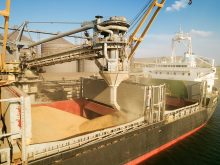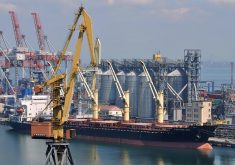A year ago, sunflower prices in North America were absurdly high.
In North Dakota, in June 2022, prices were at US$40 per hundredweight.
Converting that into dollars per acre, if a producer achieved a yield of 2,000 pounds, they would’ve earned $800 per acre from their sunflower crop.
This June, sunflower prices have returned to normal.
Old crop is priced at $19.50 per cwt. in North Dakota and new crop is about $21.
The lower price explains why sunflower acres have declined in the United States and have likely dropped in Canada.
Read Also

Huge Black Sea flax crop to provide stiff competition
Russia and Kazakhstan harvested huge flax crops and will be providing stiff competition in China and the EU.
“I expect (acres) to be flat or a little bit down,” said Morgan Cott, a special crops agronomist with the Manitoba Crop Alliance.
In 2022, Manitoba farmers seeded about 73,000 acres of sunflowers, based on Manitoba crop insurance data. Manitoba Agriculture pegged the 2022 crop at 83,000 acres. The province produces most of the sunflower crop in Canada.
Yields were decent last year but not outstanding.
The average yield was 2,057 lb. per acre, using Manitoba Agriculture estimates.
It’s possible that acres have declined, but with the warm temperatures and dry soils this spring, sunflowers could be a star in 2023.
“It would have been a good year to put them in,” Cott said, since sunflowers have a deep taproot that can acquire water 1.5 to 1.8 metres into the soil.
“The guys who did put them in will be happy, I think.”
American farmers produced a massive sunflower crop in 2022.
Acres climbed 30 percent relative to 2021 and North Dakota farmers had record yields:
- U.S. production in 2022 was 2.81 billion lb., an increase of 48 percent from 2021.
- Nearly half of America’s output came from North Dakota, which produced 1.34 billion lb., up 71 percent from 2021.
John Sandbakken, executive director of the National Sunflower Association, said U.S. sunflower production jumped last year because of the war in Ukraine.
Russia and Ukraine are major producers of sunflowers and the war pushed prices through the roof in the spring of 2022.
“In the initial part of the (Russian) invasion, there was a lot of panic that set in,” he said.
“We went to $40 (per cwt). I wouldn’t say that’s once in a lifetime, but you only hit that a few times during your (farming) career.”
With lower prices and stocks left over from 2022, American sunflower acres are expected to decline. The U.S. Department of Agriculture has pegged acres at 1.36 million, compared to 1.69 million in 2022.
At $21 to $22 per cwt, new crop prices are still decent, but global buyers and other players in the sunflower market have adjusted to the reality of the war.
“That war premium (has) been taken out of the market,” Sandbakken said from his office near Bismarck, N.D. “In the European Union and elsewhere, they adjusted. They moved on to other (vegetable) oils.”
North America may have a larger supply of sunflower seeds in 2023, but snack food manufacturers are still buying large quantities of sunflower oil.
Food processing companies in Mexico, the U.S. and Canada are using sunflower oil to make chips, salad dressings and popcorn.
“When you see a product like Skinny Pop, or SmartFood, they’re all using sunflower oil,” Sandbakken said. “(That’s) probably the biggest growth area… the popcorn, the flavoured popcorn.”
Canadian food processors are part of the trend as Canada becomes a significant market for U.S. sunflower oil.
In 2021-22, Canada bought 40,500 tonnes of sunflower oil from America, double the 20,000 tonnes imported in 2018/2019.
“It’s used in all kinds of things — marinades … frying chips,” Sandbakken said.
“In Ontario, the Toronto area, a lot of it goes into bottled oil…. There’s a larger population of folks that like using (sunflower oil) up in that area.”


















